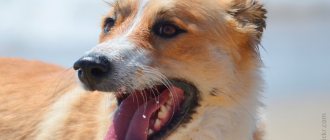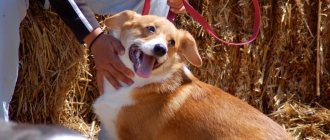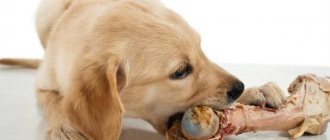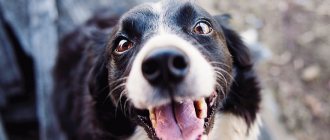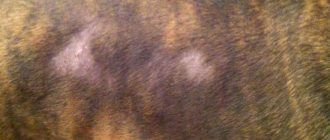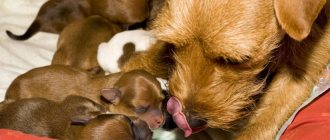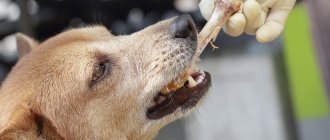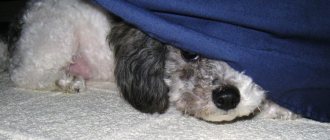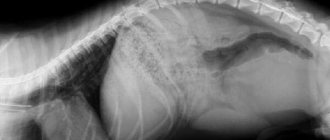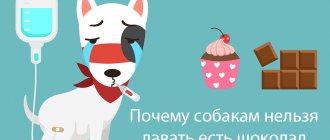Poisoning in dogs has been quite common in recent years. Basically, if a dog is poisoned, the owner of the dog is usually to blame.
Most often a dog can get poisoned when:
- During a walk, he has the opportunity to pick up low-quality food waste.
- Feeding poor quality, spoiled, sour food products.
- Failure to comply with food storage rules and regulations.
- Free access for the dog to household chemicals, fertilizers, and medicines.
- Including a large amount of meat products in your dog's diet.
Types of poisoning
Depending on the way toxic substances that can cause poisoning enter the dog’s body, as well as the type of substances that cause intoxication in the dog, poisoning is divided into:
- Food poisoning - toxic substances enter the dog's body through the mouth. The source of food poisoning can be spoiled food, medicines, and household chemicals. Sometimes poisoning in a dog can occur as a result of licking highly toxic drugs from its fur.
- Non-food poisoning - bites of poisonous snakes (the dog was bitten by a snake) or insects (the dog was bitten by a bee or wasp, what to do?). Poisoning from household chemicals, rodent baits, carbon monoxide or gasoline fumes. Overdose of medicinal substances when treating a dog for worms and fleas.
Symptoms of poisoning in a dog
Depending on the type of toxic substance and the duration of its effect on the body, poisoning in a dog may be accompanied by the following symptoms:
Loss of appetite. A poisoned dog loses its appetite. The dog stops eating its usual food, refuses treats, skips several meals, while continuing to drink water.
Drooling . Drooling in a dog is usually a sign of nausea. And excessive drooling can be a sign of food poisoning, which is followed by the appearance of a lot of foam at the mouth (the dog is drooling).
Vomit . Vomiting is a complex reflex act caused by irritation of the vomiting center, in which the contents of the dog’s stomach are thrown out through the oral cavity. Vomiting is most often a protective reaction of the dog’s body from harmful and life-threatening substances (poisonous, toxic, inedible substances) that have entered the digestive tract.
The vomit may contain blood if the dog is poisoned with rat poison, bile, etc. (vomiting in dogs).
Diarrhea . Diarrhea or diarrhea in dogs is mostly associated with damage to the gastrointestinal tract and is accompanied by liquid feces in the dog. With normal functioning of the digestive system, the dog goes to the toilet 2-4 times a day, usually after feeding, in the morning and in the evening.
The most typical thing for the owner of a dog that suffers from diarrhea will be frequent loose stools, from which a putrid, rotten, pungent or other odor emanates. At the same time, a sick dog additionally experiences flatulence (the dog has a bubbling stomach), when examining the feces we find the presence of mucus or blood, the feces become liquid and frequent. If the color of the feces themselves turns black, then this may be a sign of internal bleeding in the stomach and intestines. When diarrhea occurs, the dog becomes lethargic, its appetite decreases, the animal becomes dehydrated, and weight loss occurs (dog diarrhea).
Gastroenteritis. The main cause of gastroenteritis in dogs is nutritional factors (feeding spicy, rough, irritating, poor-quality food). Ingestion of heavy metal salts into the feed (poisoning with lead compounds, poisoning with zinc compounds), irritating drugs that damage the mucous membranes of the stomach and intestines (salicylates, glucocorticoids, anthelmintics, cytostatics, antibiotics, etc.). Often, while walking, dogs can find and eat food of unsuitable quality or completely spoiled, which can be a trigger for acute poisoning, damage to the intestinal and stomach mucosa, and, as a consequence, the development of gastroenteritis (gastroenteritis in dogs).
Lethargy. As a result of the action of toxins entering the body, the dog looks
lethargic, does not want to go for a walk, refuses to play.
Muscle tremors.
Decreased body temperature. Poisoning in animals is almost always accompanied by a decrease in body temperature.
Dermatitis is an inflammation of the superficial and deep layers of the skin. Young dogs under 5 years of age are most susceptible to the disease. Of the breeds that suffer most from dermatitis: pug, boxer, sharpei, chow chow, cocker spaniel, beagle, German shepherd, labrador, etc.
Dermatitis occurs if poison enters the dog's body from the skin. For example, if a dog during a walk had contact with Sosnovsky's hogweed. At the site of contact with a poisonous plant, redness, blisters filled with liquid, rash, swelling, and itching appear.
Seizures or tremors . In the event that a toxin that enters a dog’s body during poisoning begins to affect the central nervous system, the dog can:
- Shake.
- Lose consciousness.
- Involuntary urination.
- Involuntary bowel movements.
- Drooling appears.
Lack of coordination - the dog cannot stand up, staggers, pulls its hind legs.
Disruption of the central nervous system - the first sign is improper accommodation of the pupils, that is, they do not narrow to the light or do not dilate in moderate lighting.
Breathing is impaired. As a result of the action of toxic substances, fluid accumulates in the lungs and the functioning of the heart is disrupted. Outwardly, this manifests itself in the fact that the dog cannot take a deep breath, the nostrils are swollen when breathing, breathing becomes noisy and frequent (pulmonary edema in dogs).
There is a failure in the functioning of organs , primarily in which the neutralization and release of poisons and toxins that have entered the dog’s body occurs - hepatitis (liver disease in dogs), failure of the kidneys.
Increased sensitivity to light. When poisoned by certain poisons, a dog becomes hypersensitive to light; the dog tends to hide in a dark corner of the room or in a kennel.
Loss of consciousness. The most unfavorable symptom of poisoning is when the dog loses consciousness and stops responding to its owner. It is urgent to call a veterinarian to take emergency measures.
Obvious signs of intoxication in a dog during poisoning are observed on average after 7 hours; when a dog is poisoned with rat poison and other similar toxic substances, signs appear after 3 hours.
With the development of gradual intoxication that slowly poisons the dog’s body, symptoms of poisoning may appear within a week or even a month.
The dog was poisoned: what to do
When your dog is poisoned, you can alleviate its condition before going to the doctor. You can provoke vomiting by giving your dog a solution with soda, salt or hydrogen peroxide. You can give your dog a sorbent that helps remove harmful substances from the body, like coal or other modern means. It is important to remember that all these methods are not applicable to chemicals and toxic substances!
If your dog has ingested poisons and chemicals, then under no circumstances should you induce vomiting, since when harmful substances leave the stomach, they will have a destructive effect on the organs.
If poisoning occurs from smoke or carbon monoxide, the dog must be taken to another room or into fresh air. If poisoning is the result of poisons getting on the surface of the skin, then the area should be washed.
Of course, only a professional veterinarian can prescribe detailed treatment. He will examine the dog, take an anamnesis based on your words, carry out the necessary research operations that will help determine the exact cause of poisoning and the extent, as well as objectively assess the condition of the dog’s affected body. Only after collecting all the necessary data is treatment prescribed.
First aid for dog poisoning
If a dog is poisoned, it is very important for the owner to provide first aid in a timely manner, since the poison that enters the dog’s body begins to affect vital organs - the liver, kidneys, nervous system, etc.
In case of poisoning, it is important to quickly remove poisons from the body and toxic substances formed in the gastrointestinal tract. It is necessary to induce vomiting in the dog. Why do you need to give your dog a warm saline solution (1 tablespoon per glass of water) or hydrogen peroxide (one to one).
If the dog has eaten pills or you have overdosed on the drug, you must induce vomiting in the dog, give the dog plenty of fluids, give activated charcoal at the rate of 1 tablet per kilogram of body weight and urgently take the dog to the veterinary clinic.
For bee stings. Immediately after a bee sting, you must carefully remove the sting; Apply a gauze swab moistened with a mixture of ammonia and water to the bite site, or wash the wound with ammonia or ethyl alcohol, or just vodka.
If none of the above is present, rinse with clean water; then cold is applied to the bite site to slow down the absorption of the poison and prevent swelling; You can use folk remedies - grated parsley leaves, dandelion milky juice, and plantain leaves. You can also lubricate the bite site with honey (the meaning of this action is that hypertonic honey draws poison from the wound and prevents swelling).
In case of multiple bites, give the dog plenty of fluids.
To relieve itching, lubricate the bite site with antipruritic antiallergic ointment (sinaflane, fenistil, 1% hydrocortisone ointment, etc.).
We give the dog internally as an antihistamine - suprastin, tavegil, diphenhydramine, cetrin, edem, loratadine. The course of treatment with these tablets can be continued for several days.
If poison gets on the dog's skin, it must be washed off with water.
If a dog is poisoned by turpentine or gasoline vapors (vomiting, convulsions), pour 1-2 tablespoons of vegetable oil into the dog’s mouth, and after 15-20 minutes give a laxative.
If a dog is poisoned by vapors or gases, the dog must be urgently removed from the premises to the street.
If a dog is poisoned by household toxic chemicals and pesticides, it is necessary to induce vomiting in the dog, first pouring a large amount of water into the stomach and add activated carbon (1 tablet per 1 kg of live weight).
In case of toxic infection (as a result of feeding low-quality food). If the dog is conscious, we induce vomiting. Adsorbents are given inside the dog (activated carbon, polysorb, enterosorb, enterosgel, etc.) and we urgently contact a veterinary clinic.
You cannot independently provide first aid to a dog in case of poisoning - rat poison, concentrated acid, isoniazid, arsenic.
If a dog is poisoned, owners can give a decoction of flaxseed, starch paste, raw egg white diluted with water, and vegetable oil as a laxative.
First aid kit
Every dog owner should have a first aid kit on hand, stocked with the essentials to help his pet before arriving at the clinic or the doctor arriving at home:
- Activated carbon or kaolin.
- Vitamin B6.
- Injection syringes.
- Enema.
- Vitamin K1, K3.
- Manganese or magnesium.
- Absorbents (polypefam, enterosgel, etc.).
- Corvalol.
- Hydrogen peroxide.
Health to you and your four-legged pets!
| Material prepared by: Margarita Olegovna Samusik journalist, ecologist, curator of materials on animals and birds, together with veterinarian Egor Vitalievich Karamenyuk |
Treatment of poisoning in a veterinary clinic
Upon admission to the veterinary clinic, veterinary specialists will collect a history of poisoning from the dog owner and conduct a clinical examination of the poisoned animal. To identify the type of toxin and assess the general condition of the dog, tests will be taken for research.
Treatment for a poisoned dog will include:
- Gastric lavage.
- Performing an enema to cleanse the intestines.
- The use of diuretics to accelerate the elimination of poisons that have entered the body.
- Administration of the appropriate antidote.
- For intoxication of microbial origin - antibiotics.
- To relieve seizures - anticonvulsants.
- Medicines to normalize breathing.
- Drugs to support the functioning of the liver, kidneys and heart.
Medicines used by the clinic’s veterinary specialists for dog poisoning during intensive detoxification and rehabilitation therapy:
- For drip administration - Ringer-Locke solution, 40% glucose solution, Trisol, Nelit.
- Heart medications - caffeine, cordiamine, sulfocamphocaine.
- Antishock drugs – prednisolone, dexamethasone.
- Hepatoprotectors – intravenous administration of Essentiale.
- Antiemetic - cerucal.
- Antispasmodics – no-spa, baralgin.
- To improve the functioning of the gastrointestinal tract and liver - Liarsin, Verocal, Hepatoject.
- Antipyretic mixture – analgin with diphenhydramine.
List of human medications that are dangerous for dogs
Non-steroidal anti-inflammatory drugs (in some cases they can be prescribed by a veterinarian in a strictly defined dose, but in no case should you give these drugs on your own):
- aspirin;
- diclofenac;
- ibuprofen;
- ketorol;
- ketoprofen;
- voltaren;
- ortofen.
The use of corticosteroids is dangerous; these drugs should be administered only as prescribed by a veterinarian:
- prednisolone;
- dexafort;
- Exec.
Feeding a dog after poisoning
After treatment, you need to gradually switch to a regular feeding diet. The dog's diet should include cottage cheese, boiled liver, lean meat, raw and boiled eggs, boiled fish, liquid porridge made from rice, oatmeal or buckwheat. To make porridge more nutritious, it is better to cook it in light broth.
It is strictly forbidden to feed foods that additionally burden the dog’s liver - fried, salted, heavily seasoned, etc.
It is necessary to feed the dog in small portions, 4-5 times a day, with foods that are well absorbed by the dog’s body.
To restore normal intestinal microflora and remove toxins remaining in the dog’s body, the use of probiotics and sorbents is recommended.
If the dog refuses to eat at first, there is no need to insist. The dog should be provided with plenty of fresh water.
Prevention of poisoning
Prevention of poisoning in a dog should be based on developing in it the concept that it is forbidden to pick up edible objects from the ground, as well as take food from the hands of strangers. During a walk, it is better to walk the dog on a short leash and carefully monitor its behavior.
If the dog has not learned to ignore food on the street, it is necessary to put a muzzle on it.
The basis for the general prevention of poisoning in dogs is biologically complete feeding of dogs, taking into account their physiological state, providing them with active walks and maintaining good sanitary condition and microclimate in the place where the dog is kept. Owners should exclude low-quality and unusual food from their dog’s diet (confectionery, sweets, foods high in fat and spices, canned food, dry food and sausages). It is strictly prohibited to feed dogs pork, lamb, and sometimes fish. The food fed to dogs should not contain mechanical impurities, nitrates, nitrites, herbicides, stabilizers, drugs and other toxic substances. Dogs should always have plenty of fresh, clean water at room temperature. The feeding diet must be balanced both in terms of the set of feeds and the sugar-protein ratio, macro-microelements, vitamins (basics of feeding dogs, feeding pregnant females, feeding lactating dogs, feeding aging dogs, feeding puppies, golden rules of rational feeding of dogs) .
With proper feeding, the dog will not experience a deficiency in any substance and will stop looking for it on its own, trying food that is unfamiliar and sometimes dangerous for it.
Protein intoxication or the consequences of an unhealthy diet
The key to the health of any body is proper, balanced nutrition and dogs are no exception. If your pet does not eat ready-made professional food, then do not be lazy and carefully study the information about the dog’s diet.
Owners who believe that the more meat the better are completely mistaken. Excess muscle meat, as well as poultry meat, leads to protein poisoning. The ideal meat food for an animal is offal. Trip contains a lot of carbohydrates, which are so necessary for your pet.
Protein oversaturation is easy to determine:
- a very sickening smell began to emanate from the dog's urine;
- urine has become a strange, non-standard shade;
- the animal began to peel, most often the baldness begins from the tail, then moves to the ridge and muzzle;
- the dog's skin becomes dry and flaky (clearly noticeable when combing);
- the wool loses its brightness and softness;
- the animal constantly tries to relieve the itching by scratching;
- weight gain stops.
Oversaturation of the body with protein is cumulative. The disease can appear only after weeks of poor nutrition and at first does not bother the dog at all. Protein poisoning is easy to treat; just adjust the dog’s diet and after a while its health will return to normal.
